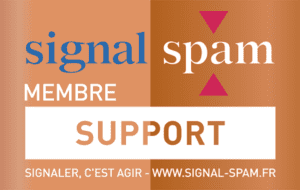Since 2007, we’ve been seeing press articles and bloggers pitting email against social networks (Facebook in the lead) and announcing that email is outdated. But it has a huge advantage: it doesn’t depend on any organization like social networks, and it’s universal.
Emailing is far from obsolete
Despite its age, email is far from obsolete for B2B use. Corporate employees have been using email since the 90s, and its use became widespread in the early 2000s.
While consumer usage changes regularly; instant messengers like Snapchat have taken market share, particularly among younger people; communication patterns are relatively stable for professionals. Corresponding by email with colleagues, customers or suppliers is perfectly natural in the workplace.
It’s an effective communication tool that has the advantage of being much less intrusive than the telephone and more formal than instant messaging. With an email, there remains a written record of a communication, whereas this is not the case with Slack or a phone call. With the rise of telecommuting in the wake of the health crisis of the 2020s, the number of emails exchanged has exploded.
So it’s certain that email will remain the primary mode of business communication for decades to come. Statistics show that there are 3.9 billion email users worldwide, compared with 40 million Facebook users. Prospecting by email therefore makes it possible to potentially contact almost all professionals (and all those with an office job).
On the negative side, professionals are very much in demand by email. As it’s a cheap prospecting channel, it’s widely used, and a communication email can easily be drowned in the mass. Not to mention deliverability problems (the fact that an email arrives in the inbox), which also degrade performance. It’s not uncommon to hear marketers complain that the return on an email campaign is falling every year.
It’s true that people are very solicited. There’s more wastage than there was 10 years ago, both in terms of the rate of completed e-mails, and in terms of opens and clicks. And the ever-increasing number of new regulatory constraints is also increasing the complexity of email marketing campaigns.
But there are always people interested.
Emailing is the most profitable outbound marketing channel
And at Ediware, we’re convinced that the B2B email prospecting channel remains the most profitable outbound marketing channel for a long time to come.
Professionals will continue to use email as their preferred means of communication. Social networks will continue to develop, but not necessarily to the detriment of email marketing. Rather, as a complement.
You simply have to work harder than before and optimize every aspect of your email marketing strategy to stand out from the crowd, despite the ever-increasing number of e-mails received by Internet users.
Despite over-solicitation, email open rates remain stable
The DMA (Data Marketing Association, formerly Syndicat National de la Communication Directe) has published the figures for the 15 leading routers in France in 2021. The 15 companies providing emailing routing services have communicated their figures for both prospecting and loyalty. Ediware took part in this study, as it does every year.
- 139.87 billion emails were sent, an increase of 12.01% on the previous year.
- Internet users receive an average of 7.44 e-mails per day
- The average open rate for these 139.87 billion emails is 18.15%.
- The average click-through rate on this same volume is 5.35%.
- Email routing is a channel with the highest return on investment of all marketing actions. Marketers consider email to be the most important strategic channel (91%), ahead of social media (83%).
The DMA France publication on e-routeurs 2021 figures is here.
If we compare the evolution of the opening rate over the last few years :
|
Year
|
Volume of emails for the
study(in billions) |
Average opening rate
|
Average click-through rate
|
|
2016
|
131
|
18,65%
|
6,41%
|
|
2017
|
133,79
|
17,20%
|
5,24%
|
|
2018
|
131,3
|
18,15%
|
5,51%
|
|
2019
|
128,25
|
17,40%
|
5,63%
|
|
2020
|
143,65
|
18,01%
|
5,30%
|
|
2021
|
139,87
|
18,15%
|
5,35%
|
(figures from the e-routeurs survey published each year by DMA France)
The performance of email marketing campaigns has remained stable over the last few years. The over-solicitation of Internet users and regulatory constraints have not reduced the performance of email marketing campaigns.
Emailing remains the preferred marketing channel for businesses
The DMA UK’s “Marketer email tracker” survey comes to the same conclusions:
“Email-marketing remains the primary channel for the majority of marketers (75%), although social networks (55%) and online advertising (35%) are effective in supporting acquisition campaigns.”
The same study indicates that despite the adoption of the RGPD, the return on investment for email-marketing campaigns remains stable overall each year. This is despite the increase in the number of emails received by each Internet user. This can be explained by the widespread adoption of best practices by companies to comply with regulatory constraints. These good practices compensate for the drop in yield induced by the growing number of recipients being solicited.
In the next article, discover the advantages of B-to-B emailing
Emailing, the essential channel for developing B-to-B business










